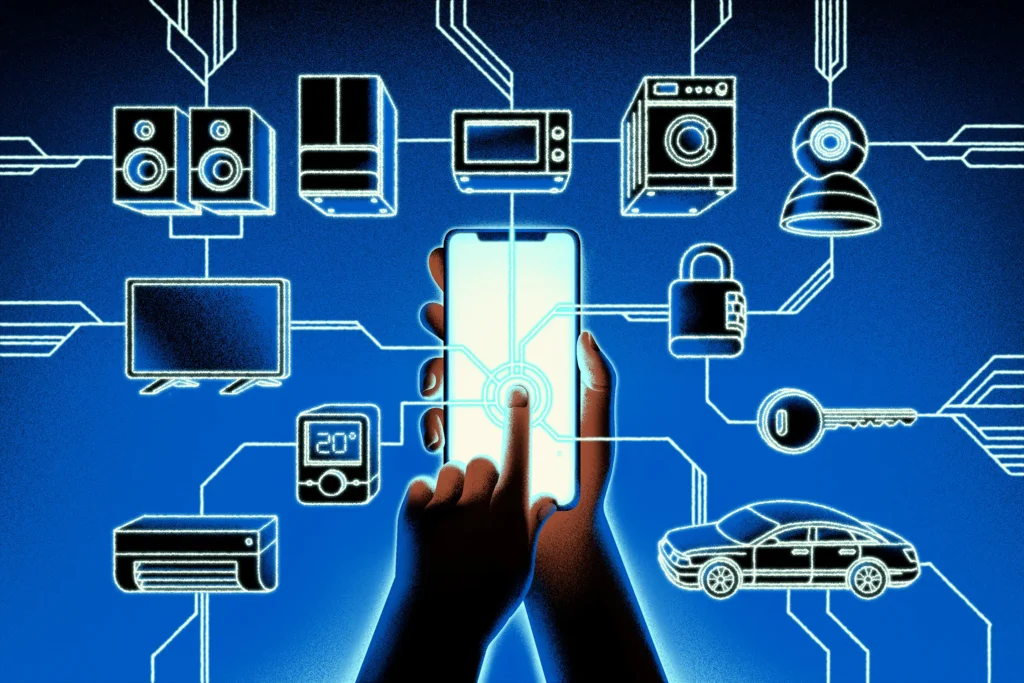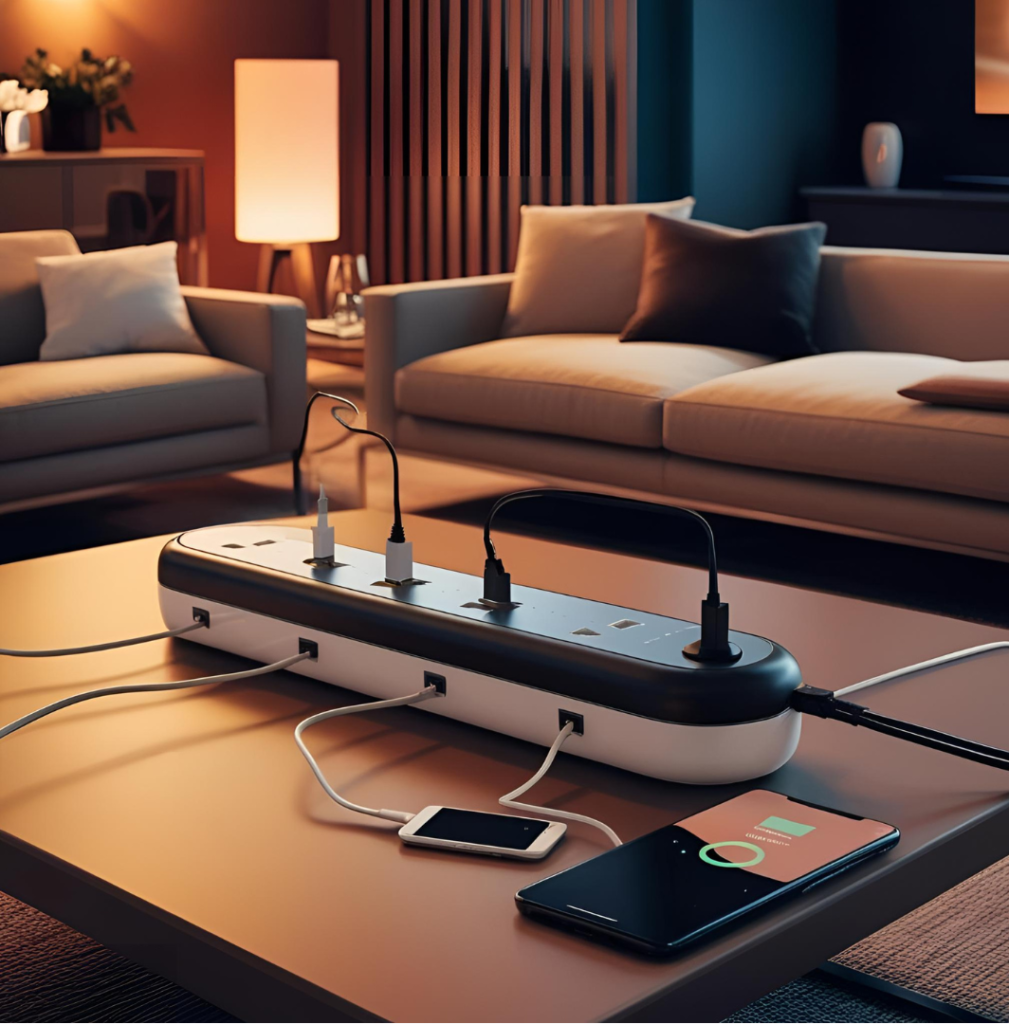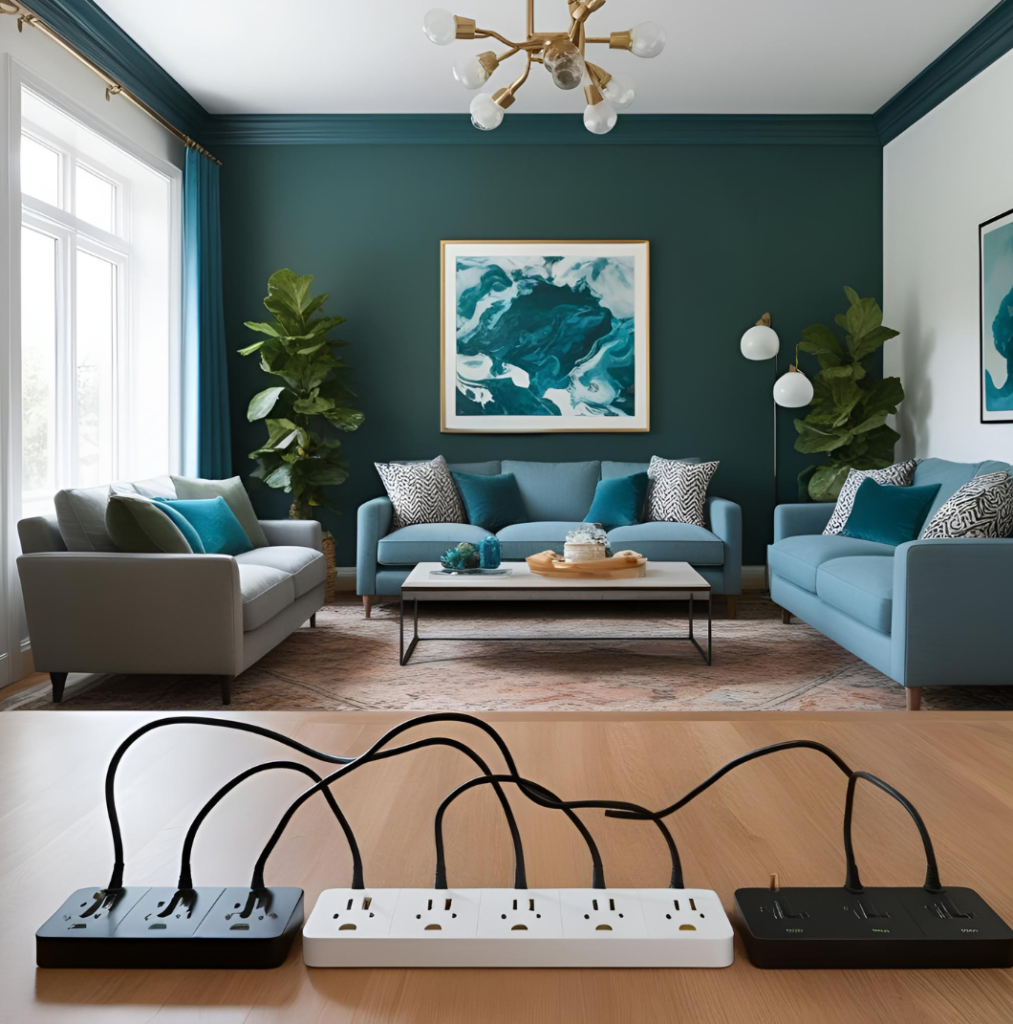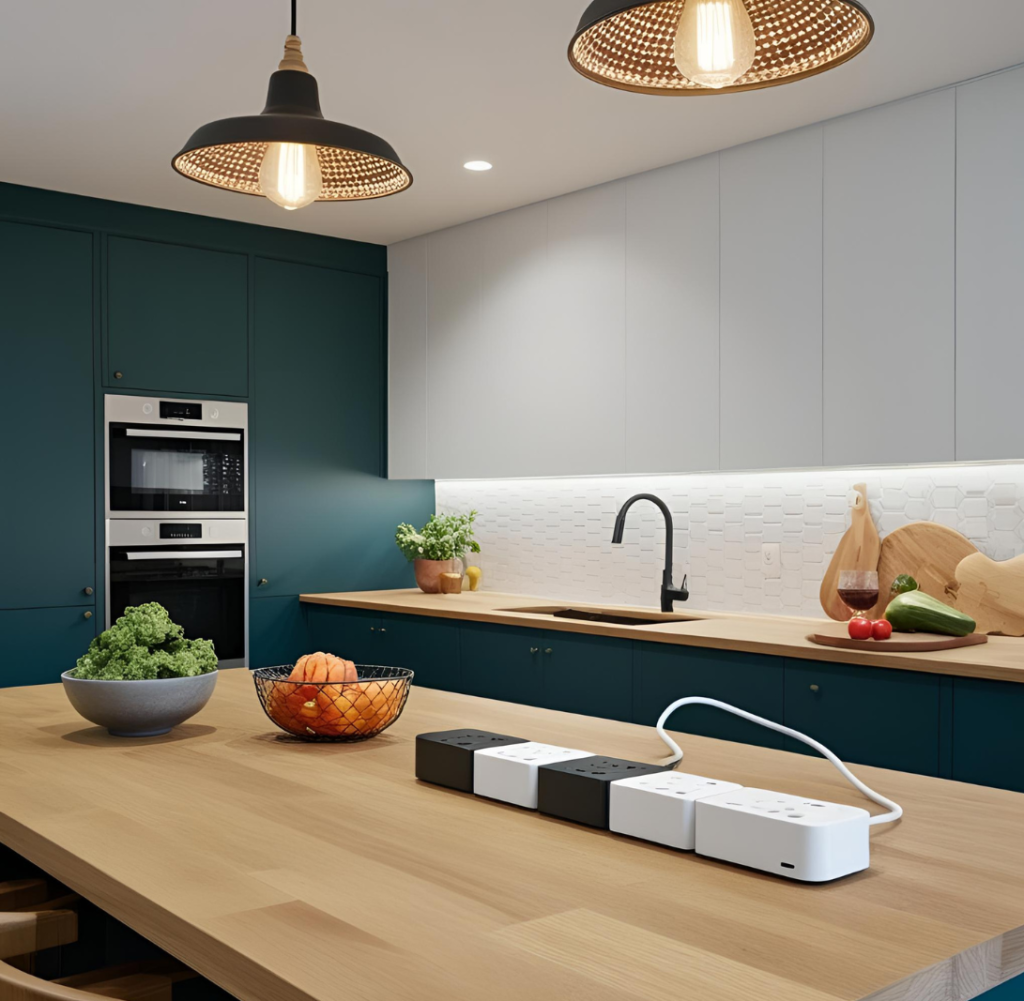Smart power strips represent the natural evolution of both traditional power strips and individual smart plugs, combining multiple controllable outlets into a single, intelligent unit. These versatile devices offer enhanced functionality, space efficiency, and cost-effectiveness for managing groups of electronics. For areas with multiple devices—entertainment centers, home offices, kitchen counters, or gaming setups—smart power strips provide comprehensive control with simplified management.

Benefits over Single Smart Plugs
Smart power strips offer several distinct advantages compared to using multiple individual smart plugs.
Space and Cost Efficiency

Smart power strips maximize both physical space and budget efficiency:
Outlet Multiplication: A single wall outlet can power and control 4-8 devices independently, eliminating outlet overcrowding.
Reduced Per-Outlet Cost: The per-outlet cost of smart power strips is typically 30-50% lower than purchasing equivalent individual smart plugs.
Space Consolidation: Eliminates the bulky stacking of multiple individual smart plugs, which often block adjacent outlets.
Cable Management: Many models include integrated cable management features, reducing cord clutter.
Single Network Connection: Uses only one connection on your WiFi network instead of multiple individual devices, reducing network congestion.
Enhanced Functionality

Beyond basic control, smart power strips often include advanced features:
Surge Protection: Most models incorporate surge protection for all connected devices, adding a layer of electrical safety.
USB Charging Ports: Integrated USB ports for charging mobile devices without using AC outlets.
Energy Monitoring: Many models track power consumption for the entire strip or individual outlets.
Scheduling Coordination: Simplified programming for related devices that operate on similar schedules.
Master/Slave Configurations: Some models allow setting a “master” outlet that controls power to “slave” outlets automatically.
Individual Outlet Control
The defining feature of smart power strips is the ability to independently control each outlet.
Control Mechanisms
Smart power strips offer multiple ways to manage individual outlets:
App-Based Control: Smartphone applications allow naming, grouping, and controlling each outlet separately.
Physical Buttons: Many models include individual on/off buttons for direct control without requiring the app.
Voice Commands: Support for specific outlet control through voice assistants (“Alexa, turn on the third outlet on my office power strip”).
Automation Rules: Each outlet can have its own schedule, triggers, and conditions.
Remote Access: Control specific outlets from anywhere with internet access.
Practical Applications
Independent outlet control enables numerous practical scenarios:
Entertainment Center Management:
- Keep the TV powered on while turning off gaming consoles
- Power down auxiliary devices (DVD players, speakers) while leaving essentials running
- Create “watch movie” mode that powers only necessary components
Home Office Optimization:
- Turn off printers and scanners when not in use while keeping computers running
- Power down monitors after work hours while maintaining network equipment
- Schedule regular power cycling for problematic devices
Kitchen Counter Organization:

- Control coffee makers, toasters, and other appliances individually
- Prevent energy waste from multiple devices in standby mode
- Create morning routines that sequence different appliances
Configuration Best Practices
To maximize the benefits of individual outlet control:
Logical Device Grouping: Organize similar devices on the same power strip for intuitive control.
Consistent Outlet Assignment: Maintain consistent outlet usage to avoid confusion (e.g., outlet #1 always for the router).
Clear Labeling: Use descriptive names in your app for each outlet based on the connected device.
Priority Planning: Place critical devices that should rarely lose power on “always-on” outlets if available.
Power Requirement Verification: Ensure the combined power draw of all devices doesn’t exceed the strip’s rating.
Energy Monitoring Capabilities
Many smart power strips include energy monitoring features that provide valuable insights into your electricity usage.
Monitoring Granularity
Different models offer varying levels of energy monitoring detail:
Whole-Strip Monitoring: Tracks total power consumption across all outlets combined.
Per-Outlet Monitoring: Provides individual power usage data for each outlet separately.
Real-Time Consumption: Shows current power draw in watts.
Historical Tracking: Records usage patterns over time (daily, weekly, monthly).
Cost Calculation: Converts energy usage to estimated cost based on your electricity rates.
Analytical Benefits
Energy monitoring enables informed decision-making:
Vampire Power Identification: Discover which devices consume significant standby power.
Usage Pattern Recognition: Identify usage trends and opportunities for scheduling optimization.
Abnormal Consumption Alerts: Detect when devices draw unusual amounts of power, potentially indicating malfunction.
Efficiency Comparison: Compare energy usage before and after implementing automation rules.
Budget Management: Track and forecast electricity costs for specific device groups.
Implementation Strategies
To maximize the value of energy monitoring features:
Baseline Establishment: Record normal power consumption for each device to recognize deviations.
Regular Reviews: Schedule monthly reviews of energy data to identify trends and optimization opportunities.
Comparative Analysis: Test different usage patterns to determine most efficient approaches.
Alert Configuration: Set up notifications for unusual power consumption patterns.
ROI Calculation: Use collected data to calculate the payback period for your smart power strip investment.
Ideal Placement Locations
Strategic placement of smart power strips maximizes their convenience and effectiveness.
Entertainment Centers
Media setups benefit significantly from smart power strip control:
Component Management: Separately control TVs, sound systems, streaming devices, and gaming consoles.
Standby Reduction: Eliminate vampire power draw from devices not in active use.
Activity-Based Scenes: Create one-touch configurations for different entertainment activities.
Remote Troubleshooting: Power cycle problematic devices remotely when streaming or connectivity issues occur.
Scheduled Shutdowns: Automatically power off entertainment systems at bedtime.
Home Office Setups
Work spaces contain numerous devices with different power requirements:
Equipment Categories: Separate always-on equipment (routers, modems) from occasionally-used devices (printers, scanners).
Work Schedule Alignment: Automatically power up office equipment at the start of workday and shut down afterward.
Energy Efficiency: Eliminate standby consumption from office equipment during non-working hours.
Charging Station: Utilize USB ports for mobile devices while managing larger equipment via AC outlets.
Video Conference Optimization: Create “meeting mode” that powers up cameras, lighting, and audio equipment.
Kitchen and Dining Areas
Countertop appliances benefit from coordinated control:
Morning Routine Sequencing: Stagger coffee maker, toaster, and other breakfast appliance activation.
Safety Automation: Ensure high-heat appliances automatically turn off after maximum run times.
Occasional-Use Management: Power specialty appliances only when needed instead of leaving them plugged in continuously.
Entertainment Integration: Coordinate kitchen TV or speakers with cooking activities.
Remote Verification: Check and turn off appliances remotely for peace of mind.
Bedroom and Living Spaces
Personal areas benefit from convenience and comfort automation:
Bedside Control: Manage reading lamps, sound machines, fans, and chargers from one location.
Morning/Evening Transitions: Create wake-up and bedtime sequences for connected devices.
Comfort Management: Control space heaters, fans, or air purifiers based on schedules or remote commands.
Guest Accommodations: Provide visitors with simple control over multiple devices without complex instructions.
Setup and Configuration Tips
Proper setup ensures you get maximum value from your smart power strip.
Physical Installation
Start with proper physical placement:
Accessibility Balance: Position where you can access physical buttons if needed, but not prominently visible.
Cable Management: Use integrated or additional cable management to minimize cord clutter.
Heat Consideration: Ensure adequate ventilation, especially when high-draw devices are connected.
Signal Strength: Verify reliable WiFi coverage at the installation location.
Power Source: Connect to a grounded outlet, ideally not controlled by a wall switch.
Network Integration
Establish reliable connectivity:
2.4GHz Connection: Most smart power strips connect only to 2.4GHz WiFi networks, not 5GHz.
Router Proximity: For initial setup, perform close to your router before moving to final location.
Dedicated SSID: Consider creating a dedicated network for smart home devices if you have many.
IP Reservation: Set static IP addresses for more reliable automation and remote access.
Firmware Updates: Complete any available updates during initial setup.
App Configuration
Optimize the software side of your smart power strip:
Descriptive Naming: Use clear, specific names for both the strip and individual outlets.
Room Assignment: Properly assign to rooms in your app for logical organization.
User Access: Configure appropriate access for household members.
Automation Rules: Start with basic schedules before creating complex conditional automations.
Voice Integration: Set up voice assistant connections with intuitive command phrases.
Troubleshooting Common Issues
Even the best smart power strips occasionally encounter problems. Here’s how to address common issues:
Connectivity Problems
When your strip loses connection:
Power Cycle: Unplug the power strip completely for 30 seconds, then reconnect.
WiFi Verification: Ensure your WiFi network is operating normally.
Distance Check: Verify the strip isn’t too far from your router or blocked by interference.
Network Congestion: If you have many smart devices, consider a router upgrade or dedicated smart home hub.
Firmware Updates: Check if updates are available to resolve known connectivity issues.
Control Inconsistencies
When outlets don’t respond as expected:
App Refresh: Force-close and reopen your control app to refresh status.
Command Verification: Confirm commands were received by observing status indicators.
Account Synchronization: Ensure all controllers (phones, tablets) are using the latest app version.
Interference Check: Verify high-power devices aren’t causing electrical interference.
Reset Consideration: As a last resort, factory reset and reconfigure the device.
Physical Malfunctions
Addressing hardware-related issues:
Outlet Testing: Test each outlet with a simple device like a lamp to identify faulty outlets.
Overload Protection: If the strip shuts down unexpectedly, check if you’ve exceeded its power rating.
Connection Inspection: Ensure all plugs are fully inserted and secure.
Surge Evaluation: After electrical storms, verify surge protection features are still functioning.
Warranty Service: Document issues for manufacturer warranty claims if needed.
Smart power strips represent an ideal balance between convenience, functionality, and value in the smart home ecosystem. By consolidating control of multiple devices while maintaining individual outlet management, they provide a practical solution for the modern connected home. Whether you’re managing an entertainment system, organizing a home office, or controlling kitchen appliances, smart power strips offer an efficient way to reduce energy waste, simplify control, and enhance the intelligence of your living space.
